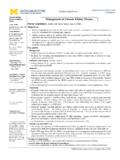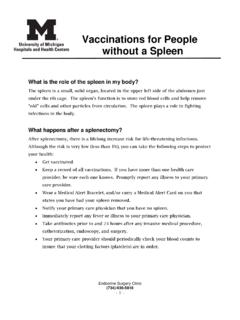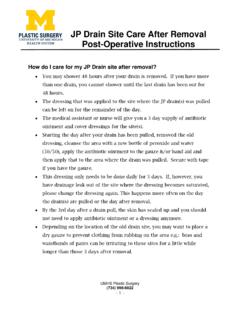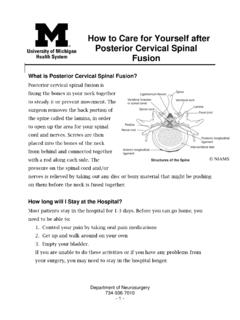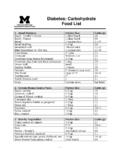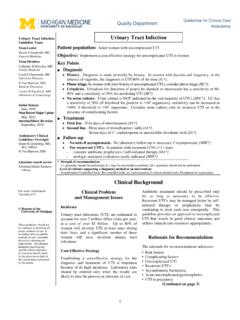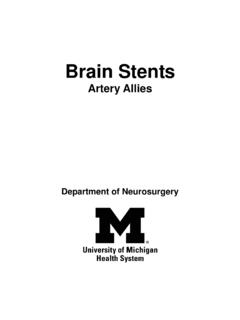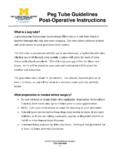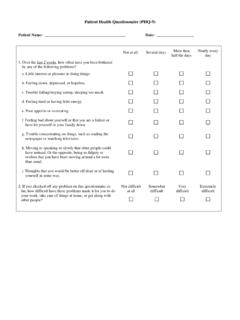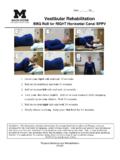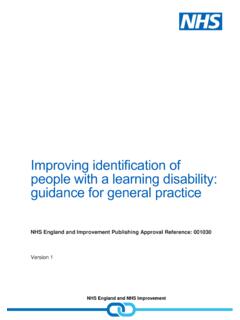Transcription of Management of Type 2 Diabetes Mellitus - Michigan Medicine
1 1 UMHS Management of Type 2 Diabetes Mellitus July 2019 Quality Department Guidelines for Clinical Care Ambulatory Diabetes Mellitus Guideline Team Team Leaders Connie J Standiford, MD General Internal Medicine Sandeep Vijan, MD General Internal Medicine Team Members Hae Mi Choe, PharmD College of Pharmacy R Van Harrison, PhD Learning Health Sciences Caroline R Richardson, MD Family Medicine Jennifer A Wyckoff, MD Metabolism, Endocrinology & Diabetes Consultants Martha M Funnell, MS, RN, CDE Diabetes Research and Training Center William H Herman, MD Metabolism, Endocrine & Diabetes Initial Release May, 1996 Most Recent Major Update September, 2012 Substantive Revisions May, 2014 Interim/Minor Revisions September, 2015, June, 2017, July 2019 Ambulatory Clinical Guidelines Oversight Karl T Rew, MD R.
2 Van Harrison, PhD Literature search service Taubman Health Sciences Library For more information 734-936-9771 Regents of the University of Michigan These guidelines should not be construed as including all proper methods of care or excluding other acceptable methods of care reasonably directed to obtaining the same results. The ultimate judgment regarding any specific clinical procedure or treatment must be made by the physician in light of the circumstances presented by the patient. Management of Type 2 Diabetes Mellitus Patient population. Adults Objectives. To reduce morbidity and mortality by improving adherence to important recommendations for preventing, detecting, and managing diabetic complications.
3 Key points Prevention. In individuals at risk for type 2 Diabetes (see Table 1), type 2 Diabetes can be delayed or prevented through diet, exercise, and pharmacologic interventions. [IA] Screening. Although little evidence is available on screening for Diabetes , screening should be considered every 3 years beginning at age 45 or annually at any age if BMI 25 kg/m2 [IID], history of hypertension [IIB], gestational Diabetes [IC], or other risk factors. Diagnosis. An A1c of or greater, confirmed by second test, is diagnostic of Diabetes . Alternatively, Diabetes can be diagnosed by two separate fasting glucoses 126 mg/dL; with symptoms, a glucose 200 mg/dL confirmed on a separate day by a fasting glucose 126 mg/dL; or 2-hour postload glucose 200 mg/dl during an oral glucose tolerance test.
4 [B] (See Table 1. See Table 2 for differential diagnosis.) Treatment. Essential components of the treatment for Diabetes include Diabetes self- Management education and support, lifestyle interventions, and goal setting (see Table 3); glycemic Management (see Tables 4-10); and pharmacologic Management of hypertension (see Table 11) and hyperlipidemia. Screening for comorbidities and complications. Routine screening and prompt treatment for cardiovascular risk factors (hypertension, hyperlipidemia, tobacco use) and for microvascular disease (retinopathy, nephropathy, neuropathy) are recommended in the time frames below. Treatment of comorbidities and complications.
5 Management of risk factors and complications is summarized in Table 12. Diet, exercise, and pharmacologic interventions should be initiated for: Hypertension [IA] Cardiovascular risk reduction [IA] Hyperlipidemia [IA] Diabetes complications as indicated Each regular Diabetes visit Annually Blood pressure measured and controlled. [IA] Check HbA1c every 3 months if on insulin; every 6 months if on oral agents or diet only and well-controlled. [II]. Optimize glycemic control. [IA] Review and reinforce diet and physical activity. [IID] Check weight, calculate BMI. [IID] Feet should be inspected at each visit if neuropathy present. Otherwise visual foot exam and neuropathy evaluation annually.
6 [IA] Smoking cessation counseling provided for patients with tobacco dependence [IB]. Review and reinforce key self- Management goals (See Table 3) [IA]. Dilated retinal examination by eye care specialist: if good blood sugar and blood pressure control and previous eye exam was normal, every 2 years; if diabetic changes, annually or more frequently per eye care provider. [IB] Treat retinopathy. [IA] Screen for microalbuminuria if not already on an ACE inhibitor or ARB. [IB] Prescribe an ACE inhibitor (or ARB, if ACE contraindicated) for microalbuminuria or proteinuria. [IA] Serum creatinine and estimated glomerular filtration rate (eGFR). [ID] Monofilament testing of feet (see Table 13).
7 [IA] Prescribe moderate dose statin; measure lipids for adherence. Smoking status assessed. [IB] All self- Management goals reviewed and reinforced. (See Table 3). Influenza vaccination (annual) and confirm or give pneumococcal and hepatitis B vaccinations. Special considerations: Pregnancy. Preconception counseling and glycemic control targeting a normal A1c in women with Diabetes Mellitus reduces the risk of congenital malformations and results in optimal maternal and fetal outcomes. [IB] * Strength of recommendation: I = generally should be performed; II = may be reasonable to perform; III = generally should not be performed. Level of evidence supporting a diagnostic method or an intervention: A=randomized controlled trials; B=controlled trials, no randomization; C=observational trials; D=opinion of expert panel.
8 2 UMHS Management of Type 2 Diabetes Mellitus July 2019 Table 1. Diagnosis of Diabetes : Diagnostic Tests and Glucose Values Diagnostic Test Normal Pre- Diabetes Diabetes Hemoglobin A1c (A1c) a < Fasting plasma glucose a < 100 mg/dL 100-125 mg/dL 126 mg/dL Random plasma glucose b < 130 mg/dL 130-199 mg/dL 200 mg/dL Oral glucose tolerance test (OGTT) 2 hours after a 75 gm oral glucose loa < 140 mg/dL 140-199 mg/dL 200 mg/dL a For A1c and fasting glucose, the diagnosis must be confirmed by a second test b A random glucose 200 mg/dL must be confirmed with a fasting glucose 126 mg/dL or the OGTT. A random glucose of 130-199 mg/dL is abnormal and further testing is indicated, eg, fasting glucose, OGTT, or hemoglobin A1c.
9 Table 2. Abbreviated Differential Diagnosis of Diabetes Type 1 Diabetes Type 2 Diabetes Diabetes due to diseases of the exocrine pancreas pancreatitis, pancreatectomy, or pancreatic adenocarcinoma cystic fibrosis hemochromatosis others Diabetes due to other endocrinopathies acromegaly Cushing s syndrome pheochromocytoma glucagonoma others Monogenic forms of Diabetes Maturity-onset Diabetes of the young Diabetes due to point mutations in mitochondrial DNA Lipoatrophic Diabetes others Drug induced Diabetes Transplant or steroid related Diabetes HIV/AIDS related Diabetes Diabetes as part of congenital syndrome Congenital rubella syndrome Down syndrome Turner's syndrome Wolfram's syndrome Myotonic dystrophy Prader-Willi syndrome Bardet-Biedl others 3 UMHS Management of Type 2 Diabetes Mellitus July
10 2019 Table 3. Self- Management Topics* At each regular visit (eg every 3-6 months) ask about: Active responsibility for own care. What do you do each day to take care of your Diabetes ? What is hardest for you to do? (Demonstrate through words and actions that Diabetes is a serious illness.) Progress toward blood pressure, glucose, and cholesterol goals. Do you know your most recent blood pressure level, HbA1c level, and LDL cholesterol levels and your progress toward your goals for these levels? Blood glucose monitoring if on insulin. Do you know (1) the rationale for monitoring your blood glucose (sick day Management , insulin dose adjustments)? (2) Your monitoring schedule? (3) How to use the results?
